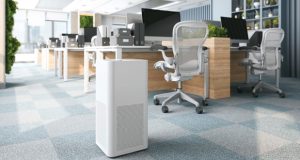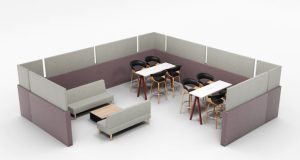FINDING A WAY
The act of navigating a path through a space – wayfinding – should inform the design of an office layout. There are clear benefits in creating a smooth flow, reducing the number of navigations necessary to get from one point to another and making a space more engaging and interactive.
Floor coverings can support wayfinding by creating a pattern to identify the best path through the office, particularly as the office becomes a more blended space, with workstations not always so easy to distinguish from social spaces. Again, flooring can be used to highlight certain areas and provide visual clues to remind workers of where they are headed.
This can be extended to cover whole teams and departments. For instance, a whole department can be allocated one colour, starting from the floor and working up so that it becomes its own community, with social spaces and meeting rooms all defined by that colour.
 The issue of sound should also impact on flooring choices. There are many noise issues attached to open-plan spaces, and flooring can be used by designers to counter such problems. Carpet muffles sound, for example, while hard floors tend to echo and add to surrounding noise, acting as an irritant and distraction. (Also, carpeting can be a good sustainable solution as many carpet manufacturers include recycled elements.)
The issue of sound should also impact on flooring choices. There are many noise issues attached to open-plan spaces, and flooring can be used by designers to counter such problems. Carpet muffles sound, for example, while hard floors tend to echo and add to surrounding noise, acting as an irritant and distraction. (Also, carpeting can be a good sustainable solution as many carpet manufacturers include recycled elements.)
However, although carpet and carpet tiles might seem the most natural choice, vertical and suspended acoustic solutions are available to counter the noise issues associated with a hard floor surface.
Of course, it’s not all about the psychology and the aesthetics. If offices have high traffic, with certain areas more likely to incur heavy footfall than others, this has to be taken into account when floor coverings are selected. Not all floor coverings are suitable for all locations, and that has to be considered in the planning stages.
Ease of repair, maintenance and footfall all have to be measured, and the lifecycle of the floor must be prioritised. That said, there is a huge range of materials to choose from, and there’s no reason why style shouldn’t coexist with practicality.
Materials such as polished concrete and patterned vinyl are considered the most durable options. However, there are now many high-quality carpet brands that can stand up to considerable wear and tear, making them suitable for inclusion in those heavy traffic areas.
When it comes to freedom of expression and creativity, there is more choice than ever before. Tiles can be configured into a multitude of designs, and colours can be matched and customised. Added to this, a mix of materials can be used to complement certain areas. For example, wooden floors for social areas and carpets for open plan.
There’s a trend for using flooring to create a more homelike, residential feel in a bid to move away from the corporate. It certainly fits with the new way of working, which is all about removing boundaries and taking a more collaborative approach.
Ultimately, all factors considered, flooring is one of the most important items on the specification list. If the choice of flooring can play any part in keeping workers more motivated and productive, it makes sense to give it every consideration.




